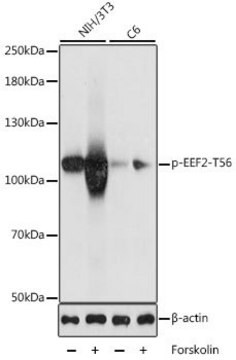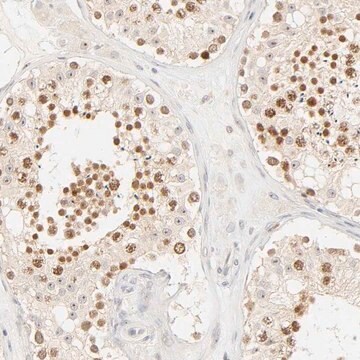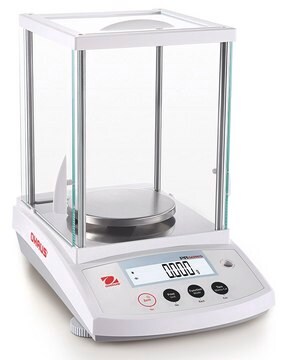일반 설명
We are committed to bringing you greener alternative products, which adhere to one or more of The 12 Principles of Green Chemistry.This antibody is Preservative-free, produced without the harm or sacrifice of animals and exceptionally stable to allow for ambient shipping and storage if needed and thus aligns with "Waste Prevention", "Designing Safer Chemicals" and "Design for Energy Efficiency".
Click here for more information.
ZooMAb® antibodies represent an entirely new generation of recombinant monoclonal antibodies.Each ZooMAb® antibody is manufactured using our proprietary recombinant expression system, purified to homogeneity, and precisely dispensed to produce robust and highly reproducible lot-to-lot consistency. Only top-performing clones are released for use by researchers. Each antibody is validated for high specificity and affinity across multiple applications, including its most commonly used application. ZooMAb® antibodies are reliably available and ready to ship when you need them.
특이성
Clone 1E11 is a ZooMAb® Rabbit recombinant monoclonal antibody that specifically detects Acetyl-CoA carboxylase 1 (ACC1) phosphorylated on serine 79.
면역원
KLH-conjugated linear peptide corresponding to 13 amino acids surrounding phosphoserine 79 from the N-terminal region of rat Acetyl-CoA carboxylase 1 (ACC1).
애플리케이션
Quality Control Testing
Evaluated by Western Blotting in lysate from NIH3T3 cells overnight starved and treated Oligomycin.
Western Blotting Analysis (WB): A 1:1,000 dilution of this antibody detected Acetyl-CoA Carboxylase 1 (ACC1) phosphorylated on serine 79 in lysate from NIH3T3 cells overnight starved and treated with 0.5 μM Oligomycin for 30 min.
Tested applications
Western Blotting Analysis (WB): A 1:1,000 dilution of this antibody detected a construct containing GST-tagged ACC1 phosphorylated on serine 79 (Lane 2) but did not react with non-phosphorylated construct (Lane 1). (Phospho-ACC1 construct: Courtesy of Dr. Jesse Rinehart, Yale University, School of Medicine).
Immunohistochemistry (Paraffin) Analysis: A 1:100 dilution from a representative lot detected Phospho-ACC1-(Ser79) in human breast cancer tissue sections.
Peptide Inhibition Assay: Target band detection in a lysate from NIH3T3 cells treated with Oligomycin (0.5 mM) was prevented by preblocking of a representative lot with the immunogen phosphopeptide, but not the corresponding non-phosphopeptide.
Note: Actual optimal working dilutions must be determined by end user as specimens, and experimental conditions may vary with the end user
표적 설명
Acetyl-CoA carboxylase 1 (UniProt: P11497; also known as EC:6.4.1.2, ACC1, ACC-alpha) is encoded by the Acaca (also known as Acac) gene (Gene ID: 60581) in rat. Acetyl-CoA carboxylase 1 (ACC1) is a multi-subunit, biotin-dependent cytosolic enzyme that catalyzes carboxylation of acetyl-CoA to produce malonyl-CoA through its two catalytic activities, biotin carboxylase (BC) and carboxyltransferase (CT). The activity of ACC can be controlled at the transcriptional level as well as by small molecule modulators and covalent modification. Two isoforms of ACC have been reported, alpha and beta that are encoded by two different genes. ACC1 is highly enriched in lipogenic tissues. Its expression is observed in brain, placenta, skeletal muscle, pancreas, and adipose tissue. It is not detected in the liver. Its levels are regulated under long term control at the transcriptional and translational levels and under short term regulation by the phosphorylation/dephosphorylation of targeted serine residues and by allosteric transformation by citrate or palmitoyl-CoA. Phosphorylation of ACC1 at serine 79 by AMP-activated protein kinase (AMPK) inhibits its activity. It occurs when glucagon or epinephrine binds to the receptors or when the energy status of the cell is low, which leads to the activation of the AMPK. The presence of fatty acids also inhibits the activities of ACC1. ACC is considered as an important target in the design of new anti-obesity drugs. This ZooMAb® recombinant monoclonal antibody, generated by our propriety technology, offers significantly enhanced specificity, affinity, reproducibility, and stability over conventional monoclonals.
물리적 형태
Purified recombinant rabbit monoclonal antibody IgG, lyophilized in PBS, 5% Trehalose, normal appearance a coarse or translucent resin. The PBS/trehalose components in the ZooMAb formulation can have the appearance of a semi-solid (bead like gel) after lyophilization. This is a normal phenomenon. Please follow the recommended reconstitution procedure in the data sheet to dissolve the semi-solid, bead-like, gel-appearing material. The resulting antibody solution is completely stable and functional as proven by full functional testing. Contains no biocide or preservatives, such as azide, or any animal by-products. Larger pack sizes provided as multiples of 25 μL.
재구성
300 μg/mL after reconstitution at 25 μL per vial. Please refer to guidance on suggested starting dilutions and/or titers per application and sample type.
저장 및 안정성
Recommend storage of lyophilized product at 2-8°C; Before reconstitution, micro-centrifuge vials briefly to spin down material to bottom of the vial; Reconstitute each vial by adding 25 μL of filtered lab grade water or PBS; Reconstituted antibodies can be stored at 2-8°C, or -20°C for long term storage. Avoid repeated freeze-thaws.
법적 정보
ZooMAb is a registered trademark of Merck KGaA, Darmstadt, Germany
면책조항
Unless otherwise stated in our catalog or other company documentation accompanying the product(s), our products are intended for research use only and are not to be used for any other purpose, which includes but is not limited to, unauthorized commercial uses, in vitro diagnostic uses, ex vivo or in vivo therapeutic uses or any type of consumption or application to humans or animals.









